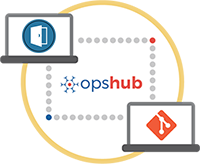IBM DOORS Integration with Git
The integration of IBM DOORS (Both DOORS and DOORS Next Generation) with Git ensures complete traceability of a requirement to the source-code level.
The product management team can keep track of all the scheduled requirements, commit trends, and enforce quality checks on commits. The Development team can access all changes/updates to a scheduled requirement in real-time.
Schedule a free 30-minute live demo with our integration experts
IBM DOORS – Git Integration Overview
In an Application Lifecycle Management (ALM) ecosystem, the choice of systems, and the collaboration between the cross-functional teams play a great role. While the choice of systems impacts the productivity of a team, cross-functional collaboration brings in collective wisdom to make better decisions, faster. Best-of-breed systems such as IBM DOORS and Git bring rich functionalities to the ecosystem. An integration between IBM DOORS (Both DOORS and DOORS Next Generation) and Git will provide complete traceability for all the requirements. This will not only help in quickly procuring all details related to the requirements later but also help fulfill even the most stringent regulatory compliance requirements.
How IBM DOORS – Git integration is beneficial for an enterprise
- Track commit volume, track commit trends and edits/changes to commit files in real-time
- Enforce authentic commits to make sure each commit is happening against a scheduled and open workitem
With IBM DOORS + Git integration, enterprises can:

How OpsHub Integration Manager integrates IBM DOORS and Git
OpsHub Integration Manager provides bi-directional integration between IBM DOORS (Both DOORS and DOORS Next Generation) and Git. It ensures that all historical and current data is available to each user, in that user’s preferred system, with full context, in real-time. All the details related to a commit made against a requirement in IBM DOORS can be tracked from IBM Rational DOORS itself. For example, for each commit that the development team makes in Git, Git synchronizes a ‘commit entity’ linked to the specificrequirement id back to IBM DOORS. Each ‘commit entity’ includes information such as ‘who did the commit?’, ‘when was the commit done?’,and ‘which part of the code was committed?’.
Popularly synchronized entities

Use Case: IBM DOORS integration with Git
Problem statement:Problem statement: The Product Management team doesn’t have visibility into the commit trends and volume. Lack of commit traceability can also lead to compliance issues.
Solution:If DOORS and Git are integrated using OpsHub Integration Manager, there will be complete traceability for each requirement in the ecosystem.
- The Product Manager creates a ‘business requirement’ in DOORS.
- The Development team works on the requirement, tests it, and then commits it in Git against the ‘requirement id’ specified in DOORS.
- For each commit that happens from the development team, OpsHub Integration Manager synchronizes a ‘commit entity’ linked to the specific requirement id back to DOORS. Each ‘commit entity’ includes information such as ‘who did the commit?’, ‘when was the commit done?’, and ‘which part of the code was committed?’.

Benefits of integration for IBM DOORS and Git users
IBM DOORS users
- Complete traceability from IBM DOORS to code base in Git
- Real-time visibility into the progress and quality of development work
- Reduced dependency on manual communication to track the completion of a requirement
Git users
- Each commit traced back to its respective workitem at any given point in time from Git itself
- Enforced checkpoints ensure high success rate for commits
- Reduced dependency on manual communication to share information related to each commit
